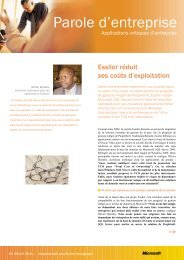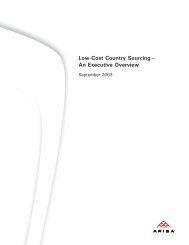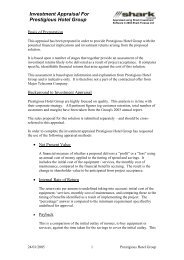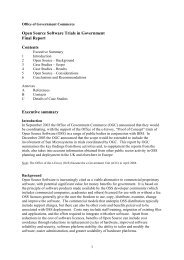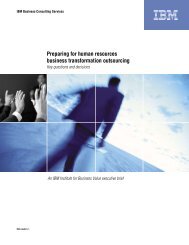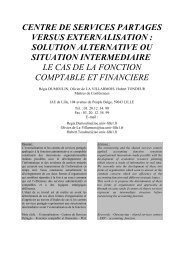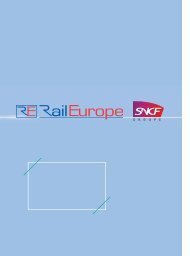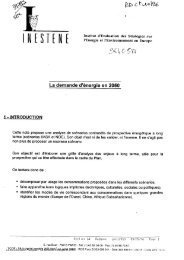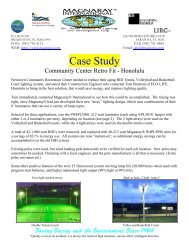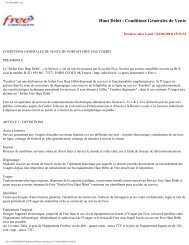Optimizing the Front Line - Costkiller
Optimizing the Front Line - Costkiller
Optimizing the Front Line - Costkiller
You also want an ePaper? Increase the reach of your titles
YUMPU automatically turns print PDFs into web optimized ePapers that Google loves.
people power performance<br />
<strong>Optimizing</strong> <strong>the</strong> <strong>Front</strong> <strong>Line</strong> Workforce<br />
Unlocking <strong>the</strong> Real Benefits of Voice Technology<br />
in Warehousing Operations<br />
A Voxware White Paper<br />
Table of Contents<br />
1. Executive Summary . . . . . . . . . . . . . . . . . . . . . . . . . . . . . . . . . . . . . . . . . . . . . . . . 2<br />
2. It's All About People . . . . . . . . . . . . . . . . . . . . . . . . . . . . . . . . . . . . . . . . . . . . . . . . 2<br />
3. Floor Logistics - More than Capturing Data . . . . . . . . . . . . . . . . . . . . . . . . . . . . . 5<br />
4. Key Enablers for <strong>Optimizing</strong> <strong>the</strong> <strong>Front</strong> <strong>Line</strong> Workforce . . . . . . . . . . . . . . . . . . . . 8<br />
5. Technology Architecture: Empower or Impede? . . . . . . . . . . . . . . . . . . . . . . . . 11<br />
6. VoiceLogistics: Maximizing <strong>the</strong> Benefits . . . . . . . . . . . . . . . . . . . . . . . . . . . . . . 13
1. Executive Summary<br />
© Copyright 2004 Voxware Inc.<br />
people power performance<br />
An increasing number of distribution center executives are turning to voice technology to improve picking<br />
operations. But for many companies, <strong>the</strong> real benefits of voice often remain untapped, despite expensive outlays<br />
for hardware and software. They settle for marginal improvements when a breakthrough is within reach. Why?<br />
The answer lies in whe<strong>the</strong>r voice technology is implemented as a tactical tool to improve a task or a strategic<br />
initiative to empower <strong>the</strong> workforce. The simplistic view is task-centric: that speech recognition is just ano<strong>the</strong>r<br />
way to capture data - in effect a humanized “talking scanner.” The strategic view is people-centric: that voice<br />
technology is a key ingredient in optimizing Floor Logistics.<br />
Floor Logistics describes <strong>the</strong> activities of warehouse workers. It is <strong>the</strong> sum of all <strong>the</strong> things <strong>the</strong>se employees<br />
do - moving about, handling products, coordinating activities, reporting on progress, receiving direction, and<br />
dealing with exceptions.<br />
The implications of optimizing Floor Logistics are profound, because <strong>the</strong> real pressing business issue in <strong>the</strong><br />
warehouse is not a given task such as picking or replenishment - it is <strong>the</strong> effectiveness and contribution of<br />
<strong>the</strong> workforce as a whole. Optimize tasks and you get incremental benefits; optimize <strong>the</strong> workforce and you<br />
get competitive advantage.<br />
The contribution of <strong>the</strong> workforce in logistics operations is crucial. Labor is <strong>the</strong> single biggest cost factor in<br />
warehousing, yet it is <strong>the</strong> least leveraged by technology. Distribution center workers have a huge impact on<br />
<strong>the</strong> ultimate bottom line - <strong>the</strong>y ei<strong>the</strong>r operate at top efficiency or waste time, make wrong decisions and<br />
o<strong>the</strong>r costly mistakes. Marginal improvements result from streamlining tasks, but breakthroughs come from<br />
a focus on people.<br />
This paper introduces Dynamic Workforce Optimization, a major advancement in warehousing technology. It<br />
is a new approach, based on a proven technology foundation. Powered by a new breed of interactive voicebased<br />
software application, it is a people-centric solution to <strong>the</strong> challenges of labor utilization in <strong>the</strong><br />
distribution center. Dynamic Workforce Optimization, through <strong>the</strong> operation of key technology enablers,<br />
improves Floor Logistics and maximizes <strong>the</strong> contribution of <strong>the</strong> front line workforce.<br />
No logistics executive wants to invest in new technology and <strong>the</strong>n fail to maximize <strong>the</strong> benefits received. That<br />
is why it is important to understand <strong>the</strong> challenges inherent to optimizing Floor Logistics and identify <strong>the</strong><br />
“must have” technology enablers that any voice-directed system must possess if it is to deliver <strong>the</strong> broadest<br />
possible benefits to <strong>the</strong> enterprise.<br />
2. It's All About People<br />
Many organizations push for high performance by striving for uniformity in all warehouse processes.<br />
Assembly line manufacturing has proven that efficiencies are improved when workers perform pre-optimized<br />
tasks repetitively. Unfortunately, this approach often falls short in <strong>the</strong> distribution center due to three<br />
fundamental facts:<br />
1. Floor Logistics activities are more complex than assembly line tasks.<br />
2. While tasks might be uniform, <strong>the</strong> people who perform <strong>the</strong>m are not.<br />
2
3. Logistics activities rarely go exactly as planned. Exceptions are a practical, day-to-day reality that<br />
prevent totally uniform processes from being achieved.<br />
This combination of complex processes, “non-uniform” humans, and exception conditions adds up to a huge<br />
management challenge - and a major opportunity to leverage technology for an operational breakthrough.<br />
Voice recognition is an ideal technology vehicle to address this challenge, but it must be applied in conjunction<br />
with people-centric software that has intelligence about <strong>the</strong> entire range of activities warehouse workers do.<br />
Let's consider <strong>the</strong> issues of <strong>the</strong> human factor in Floor Logistics.<br />
All of <strong>the</strong> activities in <strong>the</strong> distribution center are accomplished by people - but people are not interchangeable<br />
components. They differ from one ano<strong>the</strong>r. They are <strong>the</strong> backbone of any warehousing operation, and<br />
effectively managing <strong>the</strong>m is difficult because <strong>the</strong>y have:<br />
© Copyright 2004 Voxware Inc.<br />
Varying Experience and Abilities<br />
Varying Education and Motivation Levels<br />
Varying Languages and Cultures<br />
Varying Job Roles and/or Multiple Job Roles<br />
Often, <strong>the</strong> workforce is a diverse group, speaking different languages and coming from different backgrounds.<br />
In some parts of <strong>the</strong> world, a trend toward multilingual warehouses is well-established.<br />
For instance, in <strong>the</strong> United States over half of all warehouse workers speak Spanish as <strong>the</strong>ir first language,<br />
whereas over half of all managerial personnel are native English speakers. In certain US geographic areas, one<br />
can find warehouses where different workers speak Haitian French, Cuban Spanish, Mexican Spanish,<br />
Vietnamese, Cambodian, and o<strong>the</strong>r languages.<br />
In Europe, multiple language workplaces are common in virtually all border areas. In addition, <strong>the</strong> reality of<br />
cross-border labor means that a distribution center may operate with workers from widely differing home<br />
areas who may speak a common language but with very different dialects.<br />
Ano<strong>the</strong>r issue confronting management is <strong>the</strong> variety of experience and abilities in <strong>the</strong> workforce. Few warehouses<br />
are staffed with nothing but highly motivated “super workers.” Just like any o<strong>the</strong>r workforce or population,<br />
<strong>the</strong> larger <strong>the</strong> group <strong>the</strong> more likely you are to have a “bell curve” of experience and abilities (Figure 1).<br />
Figure 1: The “Ability/Experience Bell Curve”<br />
3
In a typical warehouse operation, at one end of <strong>the</strong> curve you will have some workers who are relatively new<br />
(who presumably are less effective). At <strong>the</strong> o<strong>the</strong>r end of <strong>the</strong> curve are your “super workers” who out-work and<br />
out-produce everyone else. Somewhere in <strong>the</strong> middle is <strong>the</strong> bulk of <strong>the</strong> experienced workforce.<br />
Of course, life is never as neat as a bell curve. In reality, <strong>the</strong> shape of <strong>the</strong> workforce experience curve for<br />
many companies varies with employee churn and business seasonality. Many enterprises bring on temporary<br />
workers to handle increases in volumes during <strong>the</strong> busy weeks. At those times, <strong>the</strong> experience curve is<br />
weighted more towards <strong>the</strong> left-hand side of <strong>the</strong> scale (Figure 2), and supervisory challenges are intensified<br />
because inexperienced workers naturally make more mistakes. Just when <strong>the</strong> enterprise needs especially high<br />
performance - during <strong>the</strong> busy season - what often happens is a drop in <strong>the</strong> effective contribution per worker.<br />
Figure 2: Ability/Experience Curve During <strong>the</strong> Busy Season<br />
In any warehouse, supervision - or span of control - is one of <strong>the</strong> key challenges. How is such a diverse<br />
workforce trained? How is it possible for a single supervisor to give all individual workers <strong>the</strong> on-<strong>the</strong>-spot<br />
assistance, correction, and direction <strong>the</strong>y need? Noted logistics expert Edward Frazelle writes:<br />
“The size of <strong>the</strong> warehouse also tends to increase <strong>the</strong> span of control. The greater <strong>the</strong><br />
span of control, <strong>the</strong> more skilled <strong>the</strong> managers and supervisors need to be. Unfortunately,<br />
<strong>the</strong>re is a severe shortage in <strong>the</strong> number of highly skilled warehouse operations managers<br />
and supervisors. As a result, as <strong>the</strong> warehouse grows, <strong>the</strong> management requirements can<br />
quickly exceed <strong>the</strong> management and supervisory capability.” 1<br />
How many supervisors is enough? Frazelle also notes:<br />
“Our experience shows that operator-supervisor ratios in excess of 17 to 18 do not<br />
permit adequate supervision and that ratios less than 13 to 14 are too costly.” 2<br />
One potential benefit of Dynamic Workforce Optimization technology is to effectively increase <strong>the</strong> span of<br />
control apart from adding more supervisory personnel. This can be achieved because, in effect, each worker has<br />
a “virtual supervisor” on his shoulder throughout every activity. While no technology can replace supervisory<br />
personnel, real-time workforce optimization capabilities can extend <strong>the</strong> reach of <strong>the</strong> supervisors you have.<br />
1 Frazelle, Edward. World-Class Warehousing and Material Handling, 2002, McGraw Hill, p62<br />
2 Ibid, p232<br />
© Copyright 2004 Voxware Inc.<br />
4
Figure 3: <strong>Optimizing</strong> <strong>the</strong> Contribution of Every Worker<br />
The issue here is that workforce optimization technology must take all of this variation into account. The<br />
mission is to “move <strong>the</strong> curve to <strong>the</strong> right” (Figure 3) - that is, to provide leveraging technology that benefits<br />
each employee and makes any given employee's contribution more effective than it o<strong>the</strong>rwise would be -<br />
regardless of where he or she falls on <strong>the</strong> ability/experience curve. We want temps to quickly get up to<br />
standard, experienced workers to produce like experts, and experts to be taken to new levels of effectiveness.<br />
3. Floor Logistics - More than Capturing Data<br />
If one dimension in workforce optimization is <strong>the</strong> variation and diversity of <strong>the</strong> labor pool, a second dimension<br />
is <strong>the</strong> range of complex activities <strong>the</strong> workers perform.<br />
Marginal improvements can be realized when a new technology makes an existing task easier to perform. But<br />
breakthroughs come from “thinking outside <strong>the</strong> box” to revolutionize a business process instead of making<br />
incremental changes to it.<br />
The introduction of voice technology into warehouse operations is a classic case in point. Some enterprises are<br />
implementing voice as a more efficient means of capturing data during picking and replenishment activities.<br />
But all this does is turn warehouse workers into talking scanners. While accuracy and productivity improvements<br />
may be sufficient to justify <strong>the</strong> investment in voice technology, an opportunity for greater benefits is<br />
not realized. Why?<br />
Warehouse workers do more than capture data. By some estimates, data-capture represents less than 19% of<br />
what <strong>the</strong> average warehouse worker does. Floor Logistics encompasses much more. The point in time when<br />
data is captured (whe<strong>the</strong>r via voice or a scanner) is only a small part of <strong>the</strong> overall activity. Data capture also<br />
depends on <strong>the</strong> immediate presence of a physical label or identifier of some kind. Yet, when voice technology<br />
is being employed, <strong>the</strong> worker is “wired up and connected” throughout <strong>the</strong> entire activity - why not capitalize<br />
on this fact?<br />
Dynamic Workforce Optimization is a major evolution in voice technology for <strong>the</strong> warehouse. It goes fur<strong>the</strong>r<br />
than simple data capture and task improvement because it focuses on everything <strong>the</strong> worker does, and<br />
leverages <strong>the</strong> fact that <strong>the</strong> worker is always in constant, real-time communication. Examples of issues this<br />
more strategic approach can address:<br />
© Copyright 2004 Voxware Inc.<br />
5
Figure 4: Situational Optimization - Worker Reacts to Conditions on <strong>the</strong> Floor<br />
Situational Issues. A worker is directed into a given location (Figure 4), but finds that <strong>the</strong> aisle is blocked by<br />
several of his colleagues. With Dynamic Workforce Optimization, <strong>the</strong> worker can inform <strong>the</strong> system and be<br />
immediately redirected.<br />
Figure 5: Optimized Utilization - One Worker Switches Between Job Roles<br />
Utilization Issues. Site management determines that it would be effective to have certain (but not all)<br />
selectors help out in Receiving during unexpectedly busy times. Dynamic Workforce Optimization software<br />
allows authorized workers to temporarily switch job roles (in this example from Picking to Receiving), do a<br />
new activity, and <strong>the</strong>n resume <strong>the</strong> work that was in progress (Figure 5).<br />
© Copyright 2004 Voxware Inc. 6
Figure 6: <strong>Optimizing</strong> Workgroup Contribution through Load Balancing<br />
Coordination Issues. Workers put products into totes on a conveyor. Each worker has an assigned zone of<br />
lanes from which to pick. Fast workers finish tasks before <strong>the</strong>ir colleagues and stand idle until <strong>the</strong> conveyor<br />
moves again. Dynamic Workforce Optimization balances <strong>the</strong> workload (Figure 6), varying <strong>the</strong> number of lanes<br />
assigned to each worker so that nobody is idle.<br />
Qualitative Issues. Workers can verbally identify why certain exception conditions occurred, such as a short pick<br />
because some products were damaged. This allows <strong>the</strong> WMS to be kept properly updated and synchronized.<br />
Floor Logistics is a complex set of orchestrated tasks. To deliver breakthrough benefits, Dynamic Workforce<br />
Optimization software must successfully address multiple dimensions of <strong>the</strong> Floor Logistics challenge.<br />
Among <strong>the</strong>m:<br />
© Copyright 2004 Voxware Inc.<br />
Workforce Diversity<br />
Process Complexity and Sophistication<br />
Exception Conditions<br />
The ultimate goal is to have each worker contributing at his or her maximum, and to reduce labor cost as a<br />
percentage of warehouse operating expense. In order to achieve <strong>the</strong>se goals, <strong>the</strong>re are certain technology<br />
“must haves.” They are described in <strong>the</strong> next section.<br />
7
4. Key Enablers for <strong>Optimizing</strong> <strong>the</strong> <strong>Front</strong> <strong>Line</strong> Workforce<br />
Dynamic Workforce Optimization typically utilizes a wearable computer such as <strong>the</strong> LXE MX3X, which is<br />
equipped with voice recognition and application software.<br />
Figure 7: Key Technology Enablers<br />
Whatever intelligence <strong>the</strong> solution has about worker activities and dynamic optimization is found in <strong>the</strong><br />
software. It is important that <strong>the</strong> hardware is like LXE’s MX3X: rugged, robust, and capable of operating in<br />
demanding industrial environments characterized by high noise and extreme temperatures. The key enablers<br />
for Dynamic Workforce Optimization are software-based:<br />
© Copyright 2004 Voxware Inc.<br />
Continuous One-to-One Management<br />
Personalized Performance Enhancers<br />
Activity-Based Streamlining<br />
Continuous One-to-One Management<br />
High quality supervision is a key factor in any effective warehousing operation. If cost was no object, <strong>the</strong><br />
ideal solution would be to assign a supervisor to every worker - but supervision becomes too costly when<br />
supervisor-to-worker ratios dip below 1:13.<br />
Figure 8: Continuous One-to-One Management Improves Supervisory Coverage<br />
8
Voice technology - if it is coupled with <strong>the</strong> right software - gives us <strong>the</strong> opportunity to put a supervisor “on<br />
<strong>the</strong> shoulder” of each worker. The benefit realized is a lower cost of supervision for a given number of workers<br />
(Figure 8). In a sense, Continuous One-to-One Management gives workers <strong>the</strong> “perfect supervisor” who:<br />
© Copyright 2004 Voxware Inc.<br />
Speaks many languages and thus can communicate with <strong>the</strong> worker in his or her native tongue.<br />
Is always <strong>the</strong>re, throughout every activity, from start to finish.<br />
Knows <strong>the</strong> worker's abilities, experience and job roles - and is able to provide assistance that is<br />
tailored to <strong>the</strong> specific worker.<br />
Is simultaneously working alongside all o<strong>the</strong>r workers in <strong>the</strong> warehouse (knowing <strong>the</strong>ir<br />
languages and recognizing <strong>the</strong>ir abilities and roles), and can thus coordinate workers and tasks.<br />
Is expert in <strong>the</strong> logistics processes used at <strong>the</strong> site.<br />
Has total visibility into all aspects of <strong>the</strong> warehousing operation as each shift progresses.<br />
When warehouse workers use voice technology, <strong>the</strong>y are always “connected” and available. What a wasted<br />
opportunity, when <strong>the</strong> software <strong>the</strong>y have simply uses <strong>the</strong>ir voices to capture data. So much more is possible.<br />
Continuous One-to-One Management combines knowledge of <strong>the</strong> worker with knowledge of <strong>the</strong> logistics<br />
process, real time access to <strong>the</strong> WMS, and visibility into warehouse conditions to give superlative direction and<br />
optimize what each worker can achieve. For instance:<br />
Workers are only assigned work <strong>the</strong>y are capable of performing.<br />
Authorized workers can be directed to switch - ei<strong>the</strong>r temporarily or permanently - from one<br />
function to ano<strong>the</strong>r (e.g., from Picking to helping out in Receiving).<br />
Work tasks are distributed to teams of workers based upon what each individual worker can<br />
accomplish, enabling <strong>the</strong> entire group to work at its maximum output.<br />
Errors are detected via interactive dialogs and corrected at <strong>the</strong> time when it is easiest (and<br />
cheapest) to fix <strong>the</strong>m: when <strong>the</strong>y happen.<br />
End-of-shift optimization is possible, whereby remaining work is assigned to workers according<br />
to <strong>the</strong>ir productivity rates - thus eliminating <strong>the</strong> problem of faster workers having nothing to<br />
do as <strong>the</strong> shift is ending, while slower workers are paid overtime to complete unfinished tasks.<br />
Training and “help” are provided in-line with worker activities, enabling workers to immediately<br />
ask what <strong>the</strong>y should do next without having to find a supervisor.<br />
Continuous One-to-One Management also gives site supervisors immediate visibility into logistics activities as<br />
<strong>the</strong>y occur. Workers who need personal attention can be quickly identified, thus making supervisors more<br />
effective in <strong>the</strong> use of <strong>the</strong>ir own time. In addition, an individual can be interrupted via a special message (e.g.,<br />
“Come to <strong>the</strong> Office”) without having to go out to <strong>the</strong> floor to search for <strong>the</strong> worker.<br />
Personalized Performance Enhancers<br />
There are lots of ways to give workers productivity tools, but often those tools have a “lowest common<br />
denominator” quality. They don't take individual capabilities and characteristics into account.<br />
Dynamic Workforce Optimization technology solves this problem with Personalized Performance Enhancers -<br />
software-based facilities that understand each worker's language, abilities, and job role. Samples are:<br />
9
© Copyright 2004 Voxware Inc.<br />
An “expert mode” that enables more highly skilled and experienced workers to take shortcuts<br />
and work even more productively.<br />
Assignment of higher work volumes to workers who have a track record of being able to<br />
accomplish more than <strong>the</strong> norm.<br />
The ability to immediately switch between job roles.<br />
Recognition that a given worker may operate in different physical environments (e.g., a very<br />
noisy freezer versus a quiet ambient area), with <strong>the</strong> ability to enhance system operation<br />
according to <strong>the</strong> actual location at any given time.<br />
Activity-Based Streamlining<br />
The combination of several factors makes voice technology a key ingredient for optimizing worker<br />
performance.<br />
It is continuously active, no matter where <strong>the</strong> worker is. This makes voice a “flexible cost<br />
technology” because it can be employed in many different situations and in new ways - as<br />
opposed to a "fixed cost technology" such as pick-to-light that, once deployed, is very rigid<br />
and extremely expensive to change.<br />
It is <strong>the</strong> most immediate two-way communications vehicle available - information of all types<br />
can be sent and received at any moment.<br />
It is potentially <strong>the</strong> most natural interface and requires no intervention to use: workers simply<br />
listen and speak while <strong>the</strong>ir hands and eyes are free.<br />
Speech recognition enables workers to “multi-task” - listening to prompts and responding while<br />
<strong>the</strong>y physically move about or do work using <strong>the</strong>ir hands and arms.<br />
However, as we've already noted, voice recognition by itself will not optimize Floor Logistics unless it is<br />
integrated with Dynamic Workforce Optimization software. One characteristic of that software is Activity-<br />
Based Streamlining. This is <strong>the</strong> ability of <strong>the</strong> application to react to conditions as <strong>the</strong>y occur, directing and<br />
coordinating workers to accomplish tasks in <strong>the</strong> most effective way.<br />
Three areas where Activity-Based Streamlining can be applied are:<br />
Workflow Coordination<br />
Exception Management<br />
Error Correction<br />
Floor Logistics must be well-coordinated. Activity-Based Streamlining is different from traditional WMS-based<br />
task interleaving because it takes into account workers’ individual abilities. Activity-Based Streamlining can<br />
optimize <strong>the</strong> throughput achieved by a group of workers because it knows not only <strong>the</strong> mapping of <strong>the</strong><br />
processes <strong>the</strong>y do, but also <strong>the</strong>ir individual productivity and accuracy rates. It's like having an “industrial<br />
engineer in a box,” constantly adjusting <strong>the</strong> group's work tasks for greater efficiency - but it does depend on<br />
having logistical and workforce intelligence in <strong>the</strong> application software.<br />
10
Activity-Based Streamlining provides a centralized WMS with a flood of up-to-<strong>the</strong>-second information. In<br />
general, <strong>the</strong> WMS will initiate process and inventory related tasks, while <strong>the</strong> voice application optimizes<br />
worker activities. Tasks to be performed by co-workers such as drops, replenishment, and cycle counts can be<br />
detected and initiated more quickly than with any o<strong>the</strong>r approach.<br />
Ano<strong>the</strong>r element of Activity-Based Streamlining is <strong>the</strong> provision to management of detailed, real time visibility<br />
into Floor Logistics operations. Using a web interface, managers can track activities in one or more facilities<br />
from virtually any location. Real-time visibility enables management to pinpoint situations where immediate<br />
supervisory attention is needed, and thus use supervisory resources more effectively.<br />
5. Technology Architecture: Empower or Impede?<br />
Any logistics executive who decides to bring in new technology such as voice recognition is also - knowingly<br />
or not - making a technology architecture decision. Wearable computers, servers, software, RF networks, WMS<br />
applications - all components of a solution must operate within some kind of technology architecture if <strong>the</strong>y<br />
are to effectively share information and produce results.<br />
Unfortunately, “architecture” is something you cannot readily see. It sits in <strong>the</strong> background, providing its<br />
services. However, your technology architecture has a huge impact on <strong>the</strong> flexibility and solution longevity -<br />
or lack <strong>the</strong>reof - that you will enjoy. And while at first glance it may seem as if different voice technology<br />
solutions have <strong>the</strong> same features, in reality <strong>the</strong>re are major architectural differences.<br />
Technology architectures can take advantage of industry standards, or <strong>the</strong>y can be proprietary. They can be<br />
current or outdated. They can offer options or place restrictions on future decision-making. In short, <strong>the</strong>y can<br />
empower or impede.<br />
Figure 9: Technology Architecture Overview<br />
© Copyright 2004 Voxware Inc.<br />
11
The most important technology architecture requirements for Dynamic Workforce Optimization cover different<br />
planning issues. They include:<br />
Platform Independence<br />
Multi-Modal Capabilities<br />
Continuous “Smart” Voice Recognition<br />
Human Voice Prompts<br />
Web-native Systems Technologies<br />
Platform Independence<br />
Traditionally, voice recognition solutions involve proprietary hardware - but that has now changed with LXE’s entry<br />
of <strong>the</strong> MX3X into <strong>the</strong> voice market. As has been true with all computer technology, wearable computers will<br />
evolve on a path of becoming more powerful, yet more interchangeable with standard operating environments.<br />
The benefits of platform independence are obvious to seasoned executives. Because <strong>the</strong> ultimate value of Dynamic<br />
Workforce Optimization is delivered by <strong>the</strong> software, enterprises prefer a choice in <strong>the</strong> hardware area. This helps to<br />
control cost, allows strategic vendor relationships to be leveraged, and provides flexibility for <strong>the</strong> future.<br />
Multi-Modal Capabilities<br />
As we have already noted, voice technology is a key ingredient in Dynamic Workforce Optimization - but it is not<br />
<strong>the</strong> only ingredient. Warehouse workers can accomplish some tasks - for instance, <strong>the</strong> entry of very long lot or<br />
container numbers - more efficiently by scanning than with voice.<br />
The next generation of wearable computers will be characterized by devices like <strong>the</strong> LXE MX3X, which have multimodal<br />
functionality: voice recognition plus scanning plus a screen and keyboard. When coupled with good software,<br />
<strong>the</strong> MX3X makes it possible to give workers <strong>the</strong> very best tool for any given task at hand. Such capabilities are a<br />
natural extension of Dynamic Workforce Optimization's people-centric philosophy.<br />
Multi-modal devices open up a whole new range of productivity improvements and managerial applications that<br />
will enable supervisors to get real time information and take action while <strong>the</strong>y are on <strong>the</strong> warehouse floor. These<br />
devices will be a driving force behind <strong>the</strong> mass adoption of Dynamic Workforce Optimization technology in <strong>the</strong><br />
distribution center.<br />
Continuous “Smart” Voice Recognition<br />
Virtually all voice recognition solutions for complex industrial applications are “speaker dependent,” meaning that<br />
accuracy is improved because <strong>the</strong> system “knows” who is speaking and has been trained to recognize <strong>the</strong> unique<br />
voice of each specific user. Ideally, any worker could pick up any available wearable computer and log on; this<br />
eliminates headaches that come from having to “map” specific users to specific devices.<br />
Earlier systems employed “discrete” ra<strong>the</strong>r than “continuous” voice recognition. With discrete recognition, <strong>the</strong> user<br />
must pause between words, whereas with continuous recognition <strong>the</strong> user can speak normally, using a steady stream<br />
of words. Obviously, discrete recognition is far less suitable for industrial applications because <strong>the</strong> requirement to<br />
pause would both irritate users and slow <strong>the</strong>m down to <strong>the</strong> point that <strong>the</strong> application becomes unusable.<br />
Continuous speech recognition requires sophisticated software. One “workaround” is to severely restrict <strong>the</strong><br />
vocabularies in applications in order to deliver a form of continuous recognition, but this places limits on what <strong>the</strong><br />
applications can actually do. Rich applications need rich vocabularies.<br />
© Copyright 2004 Voxware Inc.<br />
12
In addition to being continuous, voice recognition for Dynamic Workforce Optimization must also be smart. It<br />
should automatically filter out words and phrases that are not part of <strong>the</strong> application, without requiring users<br />
to fiddle around with mute buttons, headsets, or switches. This permits workers to have discussions with<br />
supervisors and colleagues as necessary, without regard to <strong>the</strong> voice application. As soon as <strong>the</strong> worker<br />
resumes a task by speaking an application prompt, <strong>the</strong> smart recognizer - which has been “listening” all along<br />
- immediately reacts and gets back to work.<br />
Human Voice Prompts<br />
Voice prompts are <strong>the</strong> directives a worker hears as he or she goes about assigned tasks. Some systems use<br />
“TTS,” or Text-to-Speech prompts - which are computer-generated commands. One major headache with TTS<br />
is that <strong>the</strong> voice sounds unnatural and machine-like. The alternative is human voice prompts - an actual<br />
prerecorded human voice.<br />
Ergonomics are very important in Dynamic Workforce Optimization technology, because every positive human<br />
factor contributes to increased productivity and accuracy. It is certainly not pleasing when workers are forced<br />
to listen to a mechanical voice all day long. Plus, in high noise environments productivity is lost because<br />
workers must constantly ask <strong>the</strong> system to repeat TTS voice prompts. The ergonomically better solution is <strong>the</strong><br />
human voice prompt.<br />
Web-native Systems Technologies<br />
Web-native systems technologies, such as Voice XML, Internet Protocols, and standard operating systems<br />
benefit <strong>the</strong> enterprise because <strong>the</strong>y lead to <strong>the</strong> lowest cost of ownership over time. Also, web-native<br />
technologies are designed for high scalability. With web-native functionality, vital information can be made<br />
available to management in real time - regardless of location.<br />
Architectures that take advantage of web-native technologies are also more stable, reliable, and “future<br />
proof” because <strong>the</strong>y are part of <strong>the</strong> standards mainstream that most IT organizations require.<br />
6. VoiceLogistics: Maximizing <strong>the</strong> Benefits<br />
Today leading enterprises are taking a fresh look at leveraging <strong>the</strong>ir front line workforce. Traditionally, this<br />
group of workers has a huge impact on corporate profits yet it is <strong>the</strong> least leveraged by technology. Forwardthinking<br />
organizations are implementing Dynamic Workforce Optimization as a major step forward in<br />
maximizing <strong>the</strong> contribution that front line labor makes.<br />
Voxware is <strong>the</strong> pioneer in Dynamic Workforce Optimization for Floor Logistics in distribution centers. Our<br />
product is VoiceLogistics®. Every day, thousands of workers in <strong>the</strong> distribution centers of leading companies<br />
like 7-Eleven, US Foodservice, Hagar, PETCO, 99 Cents Only Stores, Somerfield and Argos use VoiceLogistics to<br />
do <strong>the</strong>ir jobs in <strong>the</strong> most effective and efficient manner. Results have been impressive, with near-perfect<br />
accuracy, improved productivity, and significant cost savings in labor, training, and related operational areas.<br />
If your company is considering voice technology for <strong>the</strong> distribution center, make sure that you will be able to<br />
unlock all of <strong>the</strong> potential benefits. Look beyond specific tasks to <strong>the</strong> question of optimizing what your<br />
workforce does. By adopting <strong>the</strong> strategic, people-centric approach, you will realize maximized benefits and<br />
keep your enterprise well-positioned for <strong>the</strong> future.<br />
© Copyright 2004 Voxware Inc.<br />
13



